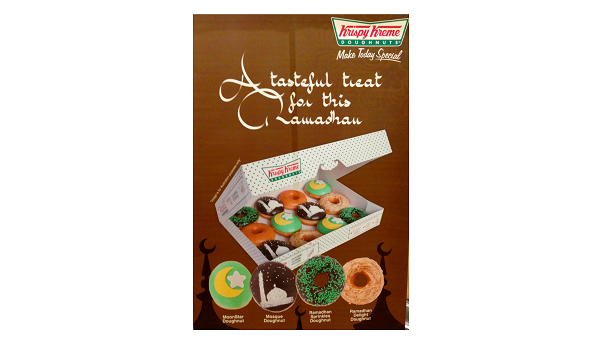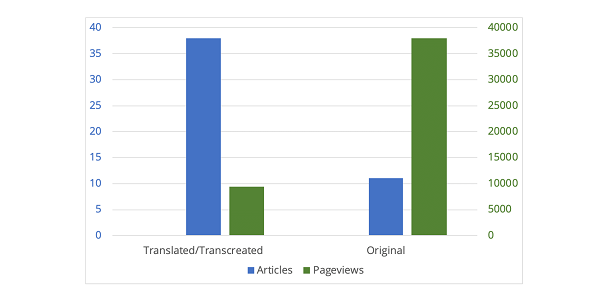Beyond Translation: How to Conquer the Global Marketing Multiverse
11 Apr 2019


Most of us would say we exist in a single dimension known as the universe. But what about the idea of a multiverse? Do you believe in the existence of infinite parallel universes, each governed by their own laws of nature?
Even if you don’t, you might have a similar thought when entering new global markets. In countries that are culturally disparate to our own, all laws of nature seem to be turned on their head. Up is down, blue is red and reaching consumers means marketing from a completely different frame of reference than in your home market.
 Not only are these donuts specially decorated for Ramadan, but the green one on the left is Pandan flavor. Heard of it? Maybe not, unless you’re familiar with Southeast Asian cuisine. Krispy Kreme catered to such a unique detail to boost their success in the Indonesian market. But how did they know to do that?
Let’s take a step back. There are three levels at which you can approach multilingual marketing.
Not only are these donuts specially decorated for Ramadan, but the green one on the left is Pandan flavor. Heard of it? Maybe not, unless you’re familiar with Southeast Asian cuisine. Krispy Kreme catered to such a unique detail to boost their success in the Indonesian market. But how did they know to do that?
Let’s take a step back. There are three levels at which you can approach multilingual marketing.
 The graph makes it crystal clear that our significantly smaller proportion of original content garnered nearly four times the number of pageviews. Content written specifically for a market, from scratch, simply performs better than another culture’s content translated into the target-market language. Maybe obvious, but often not the path chosen.
If you think about it, though, written long-form content isn’t the only type of marketing asset you might need to recreate from scratch. What about:
The graph makes it crystal clear that our significantly smaller proportion of original content garnered nearly four times the number of pageviews. Content written specifically for a market, from scratch, simply performs better than another culture’s content translated into the target-market language. Maybe obvious, but often not the path chosen.
If you think about it, though, written long-form content isn’t the only type of marketing asset you might need to recreate from scratch. What about:
Learn more: A Practical Guide to Localization for Digital Marketing
In cases like these, according to RWS Moravia’s Solutions Architect Jon Ritzdorf in a presentation at the Digital Marketing Innovation Summit, your content might need more than just translation. We’re excited to share what Jon taught about tackling the "multiverse" of global marketing with original, in-country content instead—and the results we got when we tested it.How to conquer the multiverse
The global content multiverse isn’t just a tapestry of different countries, cultures and languages. It represents entirely different ways of seeing the world. And successful global marketing takes this into account. Take a look at this Ramadan-themed campaign from Krispy Kreme Indonesia: Not only are these donuts specially decorated for Ramadan, but the green one on the left is Pandan flavor. Heard of it? Maybe not, unless you’re familiar with Southeast Asian cuisine. Krispy Kreme catered to such a unique detail to boost their success in the Indonesian market. But how did they know to do that?
Let’s take a step back. There are three levels at which you can approach multilingual marketing.
Not only are these donuts specially decorated for Ramadan, but the green one on the left is Pandan flavor. Heard of it? Maybe not, unless you’re familiar with Southeast Asian cuisine. Krispy Kreme catered to such a unique detail to boost their success in the Indonesian market. But how did they know to do that?
Let’s take a step back. There are three levels at which you can approach multilingual marketing.
- Level one: translation. We define translation as simply taking the meaning of a source language’s text and transferring it into a target language.
- Level two: transcreation. This is when the meaning can’t be easily transferred—it needs more adaptation. For instance, the baseball metaphors in the US won’t work in Indonesia (try badminton instead).
- Level three: original, in-country content. When our own "universe" isn’t at all adaptable to another, we create content completely unique to the target market with native, in-country marketers who understand their cultures’ "laws of nature."
An experiment: translated vs. original content
We have an example for you. We tested the power of original content created in-country on our own website for Japan. First, we looked at two types of content that we created for the Japanese market: a set of 38 articles that were translated or transcreated from English, and a second set of 12 articles that were originally authored in-country in Japanese. Next, we compared the viewership we earned from our original versus translated content. Take a look: The graph makes it crystal clear that our significantly smaller proportion of original content garnered nearly four times the number of pageviews. Content written specifically for a market, from scratch, simply performs better than another culture’s content translated into the target-market language. Maybe obvious, but often not the path chosen.
If you think about it, though, written long-form content isn’t the only type of marketing asset you might need to recreate from scratch. What about:
The graph makes it crystal clear that our significantly smaller proportion of original content garnered nearly four times the number of pageviews. Content written specifically for a market, from scratch, simply performs better than another culture’s content translated into the target-market language. Maybe obvious, but often not the path chosen.
If you think about it, though, written long-form content isn’t the only type of marketing asset you might need to recreate from scratch. What about:
- Video, which might require completely different actors, themes or music?
- Voice search, in which international consumers might have different intents or use different search terms?
- Social media, which lives on different platforms in other countries (like Weibo in China)?

